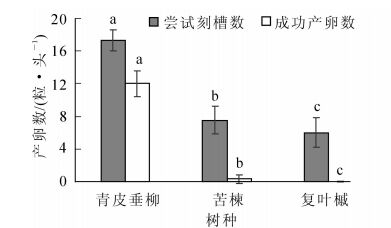-
光肩星天牛Anoplophora glabripennis(Motschulsky)属鞘翅目Coleoptera天牛科Cerambycidae沟胫天牛亚科Lamiinae星天牛属Anoplophora,是一种多食性蛀干性害虫,主要危害15个科几十种阔叶树种,包括杨属Populus,柳属Salix和槭属Acer等,广泛分布于华东和华北地区,其中在“三北”防护林和沿海防护林危害最为严重[1-5]。光肩星天牛成虫取食寄主植物的小枝和嫩叶,幼虫蛀食寄主植物的韧皮部和木质部,破坏寄主植物的输导组织,严重时甚至导致树木衰弱,最终死亡[6-7]。植食性昆虫通过寄主植物释放的挥发性次生物质,寻找、定位和识别寄主植物,进行选择性取食和产卵[8-11]。天牛亚科特殊的下口式口器,形成了一个独特的产卵方式,通过在寄主植物的树皮上咬一条缝或一个洞进行刻槽产卵[12]。光肩星天牛最喜欢在寄主植物树皮相对光滑的树干上部或主枝上产卵,但是光肩星天牛雌虫沿着树干进行产卵,甚至把卵产在因树冠枯死而暴露在外的树根上[13-14]。此外,光肩星天牛雌虫产卵的刻槽数与寄主植物的品质和种类有很大关系[12, 15]。光肩星天牛的寄主植物范围广泛,寄主挥发物成分复杂,并且光肩星天牛既危害衰弱寄主也危害健康寄主[15-16],对寄主的生理状态没有显著的偏好性,这跟一般的天牛习性不同[3, 17],这些特点都给光肩星天牛引诱剂的研究带来了很大的难度。目前,有关对光肩星天牛的防治主要还是物理防治、药剂防治和生物防治[18-19],市场上急需一种高效、绿色、无公害的光肩星天牛引诱剂。本研究期望通过研究光肩星天牛对适宜寄主的产卵行为差异,寻找影响其产卵的植物源信息素物质,为寻找一种绿色无公害的光肩星天牛引诱剂奠定基础。
-
试验所用的光肩星天牛采集于浙江省慈溪市沿海防护林(30°17′N,121°23′E,平均海拔为2.2 m)的青皮垂柳Salix ohsidare上,用捕虫网进行人工捕捉。防护林为青皮垂柳,夹竹桃Nerium indicum,海滨木槿Hibiscus hamabo,木麻黄Casuarina equisetifolia,苦楝Melia azedarach和白蜡Fraxinus chinensis等树种组成的混交林带,林地地势较为平坦,其中青皮垂柳受到光肩星天牛和星天牛危害较为严重,平均树高约为10 m,平均胸径约为30 cm,林下无其他植被。光肩星天牛成虫在5月中下旬、6月上旬陆续羽化出孔。
-
复叶槭Acer negundo,青皮垂柳和苦楝树干均采自于浙江农林大学生物测定中心旁的苗圃地。
-
产卵试验在浙江农林大学养虫室内进行,温度设为25~28 ℃,光周期14 h:10 h(光照:黑暗)。产卵试验分为无选择性产卵试验和有选择性产卵试验。无选择性产卵试验:在木质养虫笼(50 cm × 40 cm × 40 cm)内分别放入1根复叶槭、青皮垂柳和苦楝的树干(长30 cm ×直径8 cm)和大量新鲜的1年生枝条,且树干放在装有水的培养皿内,防止树干水分流失。每个养虫笼内再放入1对性成熟的光肩星天牛成虫(1雌+1雄),重复5次。有选择性产卵试验:将上述3种树干放入同一个养虫笼内,每个养虫笼再放入1对性成熟的光肩星天牛成虫(1雌+1雄),重复5次。该实验2016年6月12日开始,7月12日结束,记录每根树干上光肩星天牛的刻槽数和实际产卵数。
-
采用动态顶空吸附法分别抽取复叶槭、青皮垂柳和苦楝树干的气体挥发物。用无色无味的聚乙烯袋(55.8 cm × 44.3 cm, Reynolds, Richmond, VA, 美国)包裹树干部位,聚乙烯袋内的空气通过含有活性炭(20~40目)的玻璃管(6 mm × 150 mm内径)纯化后,将含有Super-Q吸附剂(60~80目)的TVOC不绣钢采样管(6 mm × 150 mm)与大气采样仪(QC-1S型,中国北京劳动保护研究所)进气口相连接,含有活性炭的玻璃管与大气采样仪的出气口相连接,大气采样仪的所有部件通过硅胶管连接。流速1.5 L·min-1,采样时间为6 h(10:00-16:00),重复3次·处理-1。收集的挥发物样品用含有以150.0 μg·L-1正十二烷为内标的色谱纯正己烷溶剂洗脱3次,500.0 μL·次-1,洗脱下来的样品放在-5 ℃的冰箱保存待用。
采用安捷伦气相色谱-质谱联用仪Agilent 7890A-5975C分析复叶槭、青皮垂柳、苦楝等3种寄主植物的挥发物。色谱柱为HP-5MS[30 m (长)× 0.25 mm (内径)× 0.25 μm (膜)],进样量1.0 μL,不分流进样。升温程序:初始温度40 ℃,恒温1 min,以6 ℃·min-1的速率升到250 ℃,保持3 min,再以10 ℃·min-1的速率升到270 ℃,保持5 min,共运行46 min。溶剂延迟3 min,离子源温度为230 ℃,四级杆温度为150 ℃。检测器温度为280 ℃,前进样口温度为220 ℃,电子轰击电压为70 eV,质量扫描范围为30~500。分流出口吹扫流量为60.0 mL·min-1,隔垫吹扫流量为3.0 mL·min-1。样品中挥发物成分的鉴定是通过与美国科学技术研究所(NIST)质谱库的出峰时间对比完成,定量分析通过内标正十二烷的峰面积计算。
-
用统计软件SPSS 16.0进行数据分析,刻槽数、产卵量和挥发物成分在不同寄主之间的差异显著性通过方差(ANOVA)分析,采用Duncan比较法。
-
光肩星天牛有选择性产卵试验的结果显示(图 1):光肩星天牛的尝试刻槽数和成功产卵数在青皮垂柳、苦楝和复叶槭等不同寄主植物间都显示出显著的差异(P<0.05)。其中,光肩星天牛在青皮垂柳上尝试刻槽数最多,苦楝次之,复叶槭上最少;而成功产卵数也是青皮垂柳上最多,复叶槭最少;在青皮垂柳上的产卵成功率达69.36%,而复叶槭上为0。
-
光肩星天牛无选择性产卵试验结果显示(图 2):光肩星天牛对青皮垂柳、苦楝和复叶槭树干的产卵选择性呈显著性差异(P<0.05)。光肩星天牛在青皮垂柳上的尝试刻槽数和成功产卵数最多,而苦楝和复叶槭次之,且3种寄主间呈显著性差异(P<0.05)。光肩星天牛的产卵偏好性为青皮垂柳>苦楝>复叶槭,而青皮垂柳树干上的产卵成功率高达84.44%。
-
表 1显示:青皮垂柳和苦楝分别测到16种化合物质,复叶槭检测到11种化合物质,其中烯烃类和烷烃类物质居多,醛类物质次之。3种寄主植物树干挥发物中多种成分存在显著性差异(P<0.05)。其中2-乙基已醛和3-蒈烯只在青皮垂柳中检测到,正己醛、3-己酮、正辛醛和环癸烷只有在苦楝中检测到,而复叶槭中检测到的物质在其他2种寄主植物树干中至少有1种可以检测到;丁酸丁酯、十一烷和壬醛只在青皮垂柳和苦楝中检测到,其中丁酸丁酯在苦楝中的质量浓度明显高于青皮垂柳中的质量浓度,而壬醛在青皮垂柳中的质量浓度明显高于苦楝中的质量浓度;正十六烷和正十七烷在在青皮垂柳和复叶槭中检测到,且在这2种寄主中的质量浓度没有显著性差异;?琢-蒎烯、莰烯、樟脑、十三烷和酞酸二乙酯在3种寄主植物树干中的质量浓度没有显著性差异;苯乙烯和苯乙酮在青皮垂柳中的质量浓度明显高于苦楝和复叶槭中的质量浓度,且在后2种寄主中的质量浓度没有显著性差异;2-乙基己醇和十四烷在青皮垂柳中的质量浓度明显高于复叶槭,而在青皮垂柳和苦楝中的质量浓度没有显著性差异,其中苦楝和复叶槭中2-乙基己醇的质量浓度具有显著性差异(P<0.05),而十四烷的质量浓度没有显著性差异。
表 1 3种寄主植物树干气体挥发物成分
Table 1. Chemical components of volatiles from three host plants' trunks
化合物 寄主植物树干气体挥发物质量浓度/(μg·L-1) 青皮垂柳 苦楝 复叶槭 正己醛hexanal 0b 3.85±1.04 a 0b 3-己酮3-hexanone 0b 4.86±1.59 a 0b 苯乙烯styrene 50.09±6.35 a 8.41±1.44 b 6.70±1.43 b α-薇烯a-pinene 70.80±2.93 a 74.83±5.95 a 76.10±8.94 a 莰烯camphene 11.25±1.42 a 9.38±1.57 a 10.35±1.44 a 2-乙基已醛2-ethyl-hexanal 12.06±3.63 a 0b 0b 正辛醛octanal 0b 9.24±1.71a 0b 3-蒈烯3-carene 4.91±1.05 a 0b 0b 丁酸丁酯butanoic acidbutyl ester 14.44±3.36 b 25.19±1.14 a 0c 2-乙基己醇2-ethyl-1-hexanol 161.14±29.28 a 153.36±17.06 a 121.42±5.02 b 苯乙酮acetophenone 19.73±0.94 a 11.69±0.47 b 9.48±2.79 b 十一烷undecane 17.96±2.75 a 13.15±2.76 a 0b 壬醛nonanal 107.02±17.04 a 45.74±3.45 b 0c 棒脑camphor 81.52±22.94 a 83.23±21.99 a 85.78±7.65 a 十三烷tridecane 105.12±16.35 a 93.95±7.77 a 100.59±8.53 a 十四烷tetradecane 78.17±0.93 a 65.35±2.8 ab 55.32±16.84 b 环癸烷cyclodecane 0b 48.18±7.17 a 0b 正十六烷hexadecane 33.02±6.70 a 0b 18.41±4.01 a 正十七烷heptadecane 33.09±15.23 a 0b 11.22±2.53 a 酞酸二乙酯diethyl phthalate 131.89±12.41a 137.13±18.98 a 121.20±7.86 a 说明:表中数据为平均值±标准误, 数据后标有不同字母表示差异显(P<0.05, Duncan's多重比较)。 -
光肩星天牛在青皮垂柳、苦楝和复叶槭等3种寄主植物树干上有选择性产卵和无选择性产卵试验结果都表明:光肩星天牛最喜欢在青皮垂柳上产卵,且产卵成功率较高,而最不喜欢在复叶槭上产卵,产卵成功率较低,在有选择性产卵试验中,光肩星天牛在复叶槭上的产卵成功率甚至为0。罗亚萍[20]也报道,光肩星天牛在4种寄主上成功产卵量依次为柳树Salix babylonica>苦楝>木麻黄>黄山栾树Koelreuteria bipinnata,说明柳树是光肩星天牛最偏好产卵的一种寄主,与本研究结果一致。而在每种寄主植物上的尝试刻槽数都大于实际成功产卵数,说明光肩星天牛并没有在每一个刻槽里产卵。KEENA[21]试验也表明:光肩星天牛雌虫在寄主植物树皮上咬出产卵刻痕,但最后并没有选择去产卵。这是光肩星天牛造出刻槽后发现不适合产卵,还是有意的给天敌制造一些假想从而躲避天敌,还值得进一步研究。另外,我们的观察发现:光肩星天牛的每个卵槽里最多只有1个卵,这与LINGAFELTER等[14]报道的光肩星天牛1个卵槽只产1个卵相符合。我们推测,天牛是一种具有自残性的昆虫,1个刻槽最多只有1粒卵是为了避免后代之间为竞争食物和生存环境而进行自残。
植食性昆虫通过寄主植物释放的挥发性气味对寄主植物进行识别和定位,从而进行取食和产卵[22]。在寄主植物树干气体挥发物试验中,3-蒈烯是只在青皮垂柳中检测到的2种化合物之一,产卵试验也显示,光肩星天牛最喜欢在青皮垂柳上产卵,而NEHME等[23]通过Y型嗅觉仪证明:3-蒈烯能够引起光肩星天牛雌虫的嗅觉反应,且野外试验进一步验证,3-蒈烯对光肩星天牛有吸引作用。因此,我们可以推测,3-蒈烯是一种吸引光肩星天牛产卵的植物源信息素物质。另外,壬醛只在青皮垂柳和苦楝中检测到,而且在青皮垂柳中的质量浓度明显高于苦楝。WICKHAM等[24]通过Y型嗅觉仪和野外诱捕试验表明,光肩星天牛雌虫体表物质庚醛、壬醛和十六醛按一定比例混合后对光肩星天牛雌雄都有显著的引诱作用,其中雄虫的比例更高。这些结果肯定了壬醛是一种对光肩星天牛具有引诱作用的植物源物质。最后,2-乙基己醛只在青皮垂柳中检测到,而苯乙烯和苯乙酮在青皮垂柳中的质量浓度也显著高于苦楝和复叶槭,但是没有文献报道这3种化合物对光肩星天牛行为的研究结果,需要我们进一步的试验验证。
在植物源化合物中,还有哪些是关键的引诱物质,更重要的是在什么样的比例下,才能达到最好的引诱效果,都有待于我们进一步试验,其中青皮垂柳挥发物中几种特殊成分或者主要成分的自然比例非常值得进行下一步的野外试验效果检验。
Oviposition preferences of Anoplophora glabripennis on three host plants and composition analysis of host plant volatiles
-
摘要: 光肩星天牛Anoplophora glabripennis的寄主植物范围广泛,既危害衰弱寄主也危害健康寄主。为了寻找影响光肩星天牛产卵的植物源信息物质,并为研制绿色无公害的光肩星天牛引诱剂奠定基础,通过室内有选择和无选择产卵试验,测定了光肩星天牛对青皮垂柳Salix ohsidare,苦楝Melia azedarach和复叶槭Acer negundo等3种寄主植物的产卵偏好行为,并采用动态顶空吸附法结合气相色谱-质谱联用技术(GC-MS)分析了3种寄主植物树干挥发物成分。有选择产卵试验和无选择产卵试验结果都表明:光肩星天牛最喜欢在青皮垂柳上产卵,其次是苦楝,最后是复叶槭,其中,有选择产卵试验中,光肩星天牛在青皮垂柳上的产卵成功率达69.4%,在复叶槭上的产卵成功率为0。寄主植物挥发物成分分析结果显示:青皮垂柳和苦楝分别测到16种化合物,复叶槭检测到11种化合物,其中3-蒈烯和2-乙基己醛只在青皮垂柳中检测到。另外,壬醛、苯乙烯和苯乙酮在青皮垂柳中的质量浓度显著高于苦楝和复叶槭(P < 0.05)。在以上5种化合物中,有文献报道3-蒈烯和壬醛显示出对光肩星天牛吸引作用,因此推测,3-蒈烯和壬醛可能是对光肩星天牛具有产卵引诱作用的植物源成分。Abstract: Anoplophora glabripennis (Motschulsky) have a wide range of host plants and endanger both of the health host and the stressed host. In order to find the plant volatiles which affect oviposition behaviors and lay the foundation for the development of green attractant of A. glabripennis. The oviposition preference of three host plants, Salix ohsidare, Melia azedarach and Acer negundo, was tested by laboratory the selective and no-selective oviposition test. The volatile components of three host plants were analyzed by the method of dynamic headspace adsorption to combine Gas Chromatography-Mass Spectrometry (GC/MS). The results of both the selective and the no-selective test showed that S. ohsidare was the most suitable for ovipositing by A. glabripennis, followed by M. azedarach, and finally A. negundo. The success rate of oviposition of A. glabripennis on S. ohsidare was 69.4%, and the one on A. negundo was 0. The results of host volatiles analysis showed that 16 compounds were found in S. ohsidare, and 11 compounds were detected in M. azedarach and A. negundo. 3-Carene and 2-ethyl-Hexanal only tested in S. ohsidare. The contents of nonanal, styrene, and acetophenone in S. ohsidare were significantly higher than M. azedarach and A. negundo. In the above five compounds, 3-carene and nonanal were reported to show the attraction on A. glabripennis, so we speculate that 3-carene and nonanal may be the effective components for attracting oviposition of A. glabripennis females.
-
Key words:
- forest protection /
- Anoplophora glabripennis /
- oviposition /
- host /
- volatiles /
- composition analysis
-
表 1 3种寄主植物树干气体挥发物成分
Table 1. Chemical components of volatiles from three host plants' trunks
化合物 寄主植物树干气体挥发物质量浓度/(μg·L-1) 青皮垂柳 苦楝 复叶槭 正己醛hexanal 0b 3.85±1.04 a 0b 3-己酮3-hexanone 0b 4.86±1.59 a 0b 苯乙烯styrene 50.09±6.35 a 8.41±1.44 b 6.70±1.43 b α-薇烯a-pinene 70.80±2.93 a 74.83±5.95 a 76.10±8.94 a 莰烯camphene 11.25±1.42 a 9.38±1.57 a 10.35±1.44 a 2-乙基已醛2-ethyl-hexanal 12.06±3.63 a 0b 0b 正辛醛octanal 0b 9.24±1.71a 0b 3-蒈烯3-carene 4.91±1.05 a 0b 0b 丁酸丁酯butanoic acidbutyl ester 14.44±3.36 b 25.19±1.14 a 0c 2-乙基己醇2-ethyl-1-hexanol 161.14±29.28 a 153.36±17.06 a 121.42±5.02 b 苯乙酮acetophenone 19.73±0.94 a 11.69±0.47 b 9.48±2.79 b 十一烷undecane 17.96±2.75 a 13.15±2.76 a 0b 壬醛nonanal 107.02±17.04 a 45.74±3.45 b 0c 棒脑camphor 81.52±22.94 a 83.23±21.99 a 85.78±7.65 a 十三烷tridecane 105.12±16.35 a 93.95±7.77 a 100.59±8.53 a 十四烷tetradecane 78.17±0.93 a 65.35±2.8 ab 55.32±16.84 b 环癸烷cyclodecane 0b 48.18±7.17 a 0b 正十六烷hexadecane 33.02±6.70 a 0b 18.41±4.01 a 正十七烷heptadecane 33.09±15.23 a 0b 11.22±2.53 a 酞酸二乙酯diethyl phthalate 131.89±12.41a 137.13±18.98 a 121.20±7.86 a 说明:表中数据为平均值±标准误, 数据后标有不同字母表示差异显(P<0.05, Duncan's多重比较)。 -
[1] 骆有庆, 李建光.光肩星天牛的生物学特性及发生现状[J].植物检疫, 1999, 13(1):5-7. LUO Youqing, LI Jianguang. Bionomics and occurrence of Anoplophora glabripennis (Motschulsky)[J]. Plant Quarant, 1999, 13(1):5-7. [2] NRHME M E, KEENA M A, ZHANG A, et al. Evaluating the use of male-produced pheromone components and plant volatiles in two trap designs to monitor Anoplophora glabripennis[J]. Environ Entomol, 2010, 39(1):169-176. [3] HÉRARD F, CIAMPITTI M, MASPERO M, et al. Anoplophora species in Europe:infestations and management processes[J]. Eppo Bull, 2006, 36(3):470-474. [4] 骆有庆, 刘荣光, 许志春, 等.防护林杨树天牛灾害的生态调控理论与技术[J].北京林业大学学报, 2002, 24(5):160-164. LUO Youqing, LIU Rongguang, XU Zhichun, et al. Theories and technologies of ecologically regulating poplar longhorned beetle disaster in shelter forest[J]. J Beijing For Univ, 2002, 24(5):160-164. [5] HAACK R A, HÉRARD F, SUN Jianghua, et al. Managing invasive populations of Asian longhorned beetle and citrus longhorned beetle:a worldwide perspective[J]. Annu Rev Entomol, 2010, 55(1):521-546. [6] WILLIAMS D W, LI Guohong, GAO Ruitong. Tracking movements of individual Anoplophora glabripennis (Coleoptera:Cerambycidae) adults:application of harmonic radar[J]. Environ Entomol, 2004, 33(3):644-649. [7] 高瑞桐, 秦锡祥, 陈德钧, 等.光肩星天牛危害对杨树损失的研究[J].林业科学研究, 1993, 6(2):189-193. GAO Ruitong, QIN Xixiang, CHEN Dejun, et al. A study on the damage of poplar caused by Anoplophora glabripennis[J]. For Res, 1993, 6(2):189-193. [8] KESSLER A, BALDWIN I T. Defensive function of herbivore-induced plant volatile emissions in nature[J]. Science, 2001, 291(5511):2141-2144. [9] FRANCIS F, LOGNAY G, HAUBRUGE E. Olfactory responses to aphid and host plant volatile releases:(E)-β-farnesene an effective kairomone for the predator Adalia bipunctata[J]. J Chem Ecol, 2004, 30(4):741-755. [10] ZHU Junwei, COSSÉA A, OBRYCKI J J, et al. Olfactory reactions of the twelve-spotted lady beetle, Coleomegilla maculata and the green lacewing, Chrysoperla carnea to semiochemicals released from their prey and host plant:electroantennogram and behavioral responses[J]. J Chem Ecol, 1999, 25(5):1163-1177. [11] 李建光, 骆有庆, 金幼菊.复叶槭挥发性物质对光肩星天牛的触角电位反应[J].北京林业大学学报, 1999, 21(4):1-5. LI Jianguang, LUO Youqing, JIN Youju. Electroantennogram activity of ash leaf maple(Acer negundo) volatiles to Anoplophora glabripennis (Motsch.)[J]. J Beijing For Univ, 1999, 21(4):1-5. [12] HANKS L M. Influence of the larval host plant on reproductive strategies of cerambycid beetles[J]. Annu Rev Entomol, 1999, 44(1):483-505. [13] HAACK R A, LAW K R, MASTRO V C, et al. New York's battle with the Asian long-horned beetle[J]. J For, 1997, 95(12):11-15. [14] LINGAFELTER S W, HOEBEKE E R. Revision of the Genus Anoplophora (Coleoptera:Cerambycidae)[R]. Washington D C:Entomological Society of Washington, 2002:143-149. [15] 姚万军, 杨忠岐.利用管氏肿腿蜂防治光肩星天牛技术研究[J].环境昆虫学报, 2008, 30(2):127-134. YAO Wanjun, YANG Zhongqi. Studies on biological control of Anoplophora glabripennis (Coleoptera:Cerambycidae) with a parasitoid, Sclerodermus guani (Hymenoptera:Bethylidae)[J]. J Environ Entomol, 2008, 30(2):127-134. [16] HAACK R A. Exotic bark-and wood-boring Coleoptera in the United States:recent establishments and interceptions[J]. Canad J For Res, 2006, 36(2):269-288. [17] FAN Jianting, SUN Jianghui. Influences of host volatiles on feeding behaviour of the Japanese pine sawyer, Monochamus alternatus[J]. J Appl Entomol, 2006, 130(4):238-244. [18] HAACK R A, FRANK S J. Nutritional ecology of wood-feeding Coleoptera, Lepidoptera, and Hymenoptera[G]//SLANSKY F, RODRIGUEZ J G. Nutritional Ecology of Insects Mites Spiders, and Related Invertebrates. New York:Wiley-Interscience, 1987:449-486. [19] 秦凯伦, 胡春祥, 王忠杰.不同药剂对哈尔滨市光肩星天牛的防治试验[J].东北林业大学学报, 2009, 37(9):97-98. QIN Kailun, HU Chunxiang, WANG Zhongjie. Control effects of five pesticides on Anoplophora glabripennis in Harbin[J]. J Northeast For Univ, 2009, 37(9):97-99. [20] 罗亚萍. 光肩星天牛的寄主选择行为和植物源引诱剂研究[D]. 杭州: 浙江农林大学, 2013. LUO Yaping. The Host Choice Behavior of Anoplophora glabripenn and the Research of Lure from Host[D]. Hangzhou:Zhejiang A & F University, 2013. [21] KEENA M A. Anoplophora glabripennis (Coleoptera:Cerambycidae) fecundity and longevity under laboratory conditions:comparison of populations from New York and Illinois on Acer saccharum[J]. Enviro Entomol, 2002, 31(3):490-498. [22] MOREWOOD W D, NEINER P R, MCNEIL J R, et al. Oviposition preference and larval performance of Anoplophora glabripennis (Coleoptera:Cerambycidae) in four eastern north American hardwood tree species[J]. Environ Entomol, 2003, 32(5):1028-1034. [23] NEHME M E, KEENA M A, ZHANG A, et al. Attraction of Anoplophora glabripennis to male-produced pheromone and plant volatiles[J]. Environ Entomol, 2009, 38(6):1745-1755. [24] WICKHAM J D, XU Zhichun, TEALE S A. Evidence for a female-produced, long range pheromone of Anoplophora glabripennis (Coleoptera:Cerambycidae)[J]. Insect Sci, 2012, 19(3):355-371. -

-
链接本文:
https://zlxb.zafu.edu.cn/article/doi/10.11833/j.issn.2095-0756.2017.06.013




 下载:
下载:




